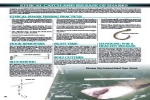Nanolatticed Architecture Mitigates Damage in Shark Egg Cases
Nanolatticed Architecture Mitigates Damage in Shark Egg Cases Rubayn Goh, Scott P. O. Danielsen, Eric Schaible, Robert M. McMeeking, J. Herbert Waite ABSTRACT: Structural versatility and multifunctionality of biological materials have resulted in countless bioinspired strategies seeking to emulate the properties of nature. The nanostructured egg case of swell sharks is one of the toughest
Small localized breeding populations in a widely distributed coastal shark species
Small localized breeding populations in a widely distributed coastal shark species B.D. Postaire, K. A. Feldheim, G. M. Clementi, J. Quinlan, M. P. M. van Zinnicq Bergmann, E. J. Brooks, R. D. Grubbs, T. L. Guttridge, A. C. Henderson, R. Tavares, D. D. Chapman ABSTRACT: Identifying the geographical scale at which natural populations structure themselves
Bias-corrected citizen science data inform habitat suitability for the angelshark
Modelling Critically Endangered marine species: Bias-corrected citizen science data inform habitat suitability for the angelshark (Squatina squatina) Nicola Noviello, Christopher McGonigle, David M. P. Jacoby, Eva K. M. Meyers, David Jiménez-Alvarado, Joanna Barker ABSTRACT: As an increasingly important resource in ecological research, citizen scientists have proven dynamic and cost-effective in the supply of data for
Microplastics in fecal samples of whale sharks
Microplastics in fecal samples of whale sharks (Rhincodon typus) and from surface water in the Philippines Yong, M.M.H., Leistenschneider, C., Miranda, J.A. et al. ABSTRACT: Marine plastic abundance has increased over the past 60 years and microplastics (< 5 mm) constitute a primary component of such litter. Filter-feeding megafauna, such as the whale shark, might be particularly affected
Portuguese Artisanal Fishers’ Knowledge About Elasmobranchs
Portuguese Artisanal Fishers’ Knowledge About Elasmobranchs—A Case Study Priscila M. Silva, Célia M. Teixeira, Cristina Pita, Henrique N. Cabral, Susana França ABSTRACT: The high economic value of fisheries was historically associated to commercial teleost fishes. Since the 1970s, despite some elasmobranchs becoming an important target or a bycatch, relatively little research has been carried out
The Impact of Short-Term Shark Liver Oil Supplementation on the Fatty Acid Composition of Erythrocyte Membranes
The Impact of Short-Term Shark Liver Oil Supplementation on the Fatty Acid Composition of Erythrocyte Membranes Zakrzewska, K.; Oszajca, K.; Zep, W.; Piekarska, A.; Sidorkiewicz, M. ABSTRACT: Fatty acid (FA) balance is strictly related to human health. The composition of fatty acids in lipid membranes seems to be influenced by diet. Shark liver oil (SLO)
Ecological risk assessment of elasmobranchs caught in the Gulf of Papua prawn fishery
Ecological risk assessment of elasmobranchs caught in the Gulf of Papua prawn fishery Leontine Baje, Andrew Chin, William T. White, Colin A. Simpfendorfer ABSTRACT: One-third of all elasmobranch species currently known to occur in Papua New Guinea are taken as bycatch in the Gulf of Papua trawl fishery. An ecological risk assessment was conducted on
Sharks and New Zealand news media
Sharks and New Zealand news media Oscar Schouten Reid, Fabien Medvecky ABSTRACT: Sharks are among the most feared animals in the world. Sharks are also among the most misrepresented. Historically, mass media has disproportionately portrayed sharks as deadly and dangerous human killers through melodramatic headlines, sensationalised stories and overly graphic accounts. This study builds on
First genetically confirmed records of the little gulper shark from Cypriot waters
First genetically confirmed records of the little gulper shark Centrophorus uyato (Squaliformes: Centrophoridae) from Cypriot waters Vasiliki Kousteni, Marios Papageorgiou, Michail Rovatsos, Ioannis Thasitis, Louis Hadjioannou ABSTRACT: The taxonomy within the genus Centrophorus has been controversial almost since its origin, raising uncertainties about the identification, the phylogenetic placement and the geographical distribution of several species.
Secondary predation constrains DNA-based diet reconstruction in two threatened shark species
Secondary predation constrains DNA-based diet reconstruction in two threatened shark species Mark de Bruyn, Matteo Barbato, Joseph D. DiBattista, Matt K. Broadhurst ABSTRACT: Increasing fishing effort, including bycatch and discard practices, are impacting marine biodiversity, particularly among slow-to-reproduce taxa such as elasmobranchs, and specifically sharks. While some fisheries involving sharks are sustainably managed, collateral mortalities
Non-random Co-occurrence of Juvenile White Sharks at Seasonal Aggregation Sites in Southern California
Non-random Co-occurrence of Juvenile White Sharks (Carcharodon carcharias) at Seasonal Aggregation Sites in Southern California James M. Anderson, Alyssa J. Clevenstine, Brian S. Stirling, Echelle S. Burns, Emily N. Meese, Connor F. White, Ryan K. Logan, John O’Sullivan, Patrick T. Rex, Jack May (III), Kady Lyons, Chuck Winkler, Emiliano García-Rodríguez, Oscar Sosa-Nishizaki, Christopher G. Lowe
Age and growth estimates of the blue shark from Papua New Guinea
Preliminary age and growth estimates of the blue shark (Prionace glauca) from Papua New Guinea Sushmita Mukherji, Jonathan Smart, Brooke D’Alberto, Leontine Baje, Andrew Chin, William White, Colin A. Simpfendorfer ABSTRACT: Blue sharks (Prionace glauca) are recognised as one of five key pelagic shark species in the Western Central Pacific Ocean (WCPO) due to their
Elasmobranch microbiomes
Elasmobranch microbiomes: emerging patterns and implications for host health and ecology Cameron T. Perry, Zoe A. Pratte, Ana Clavere-Graciette, Kim B. Ritchie, Robert E. Hueter, Alisa L. Newton, G. Christopher Fischer, Elizabeth A. Dinsdale, Michael P. Doane, Krystan A. Wilkinson, Kim Bassos-Hull, Kady Lyons, Alistair D. M. Dove, Lisa A. Hoopes, Frank J. Stewart ABSTRACT:
Effectiveness Against White Sharks of the Rpela Personal Shark Deterrent Device Designed for Surfers
Effectiveness Against White Sharks of the Rpela Personal Shark Deterrent Device Designed for Surfers Blount, Craig; Pygas, Dan; Lincoln Smith, Marcus P.; McPhee, Daryl P.; Bignell, Colby; and Ramsey, Ocean ABSTRACT: Many shark bites to humans, including fatalities, have involved surfers. Various personal shark deterrents are commercially available to surfers, including Rpela v2, which is
Info Sheet: Ethical Catch and Release of Sharks
ETHICAL CATCH AND RELEASE OF SHARKS PDF-DOWNLOAD




